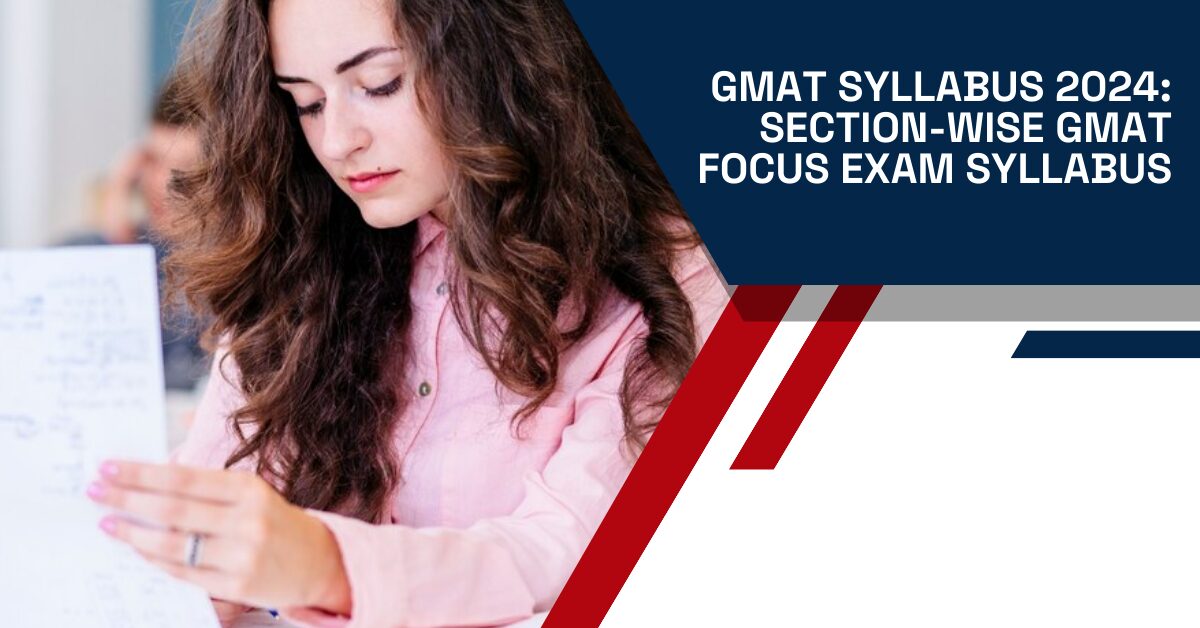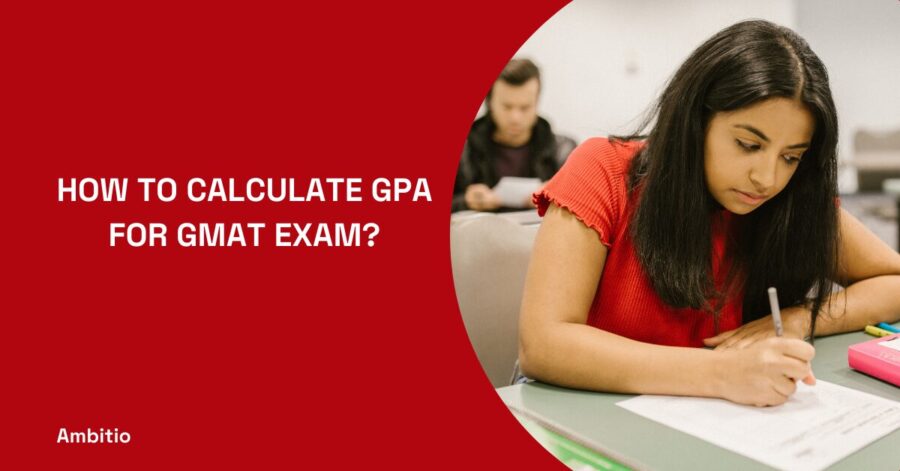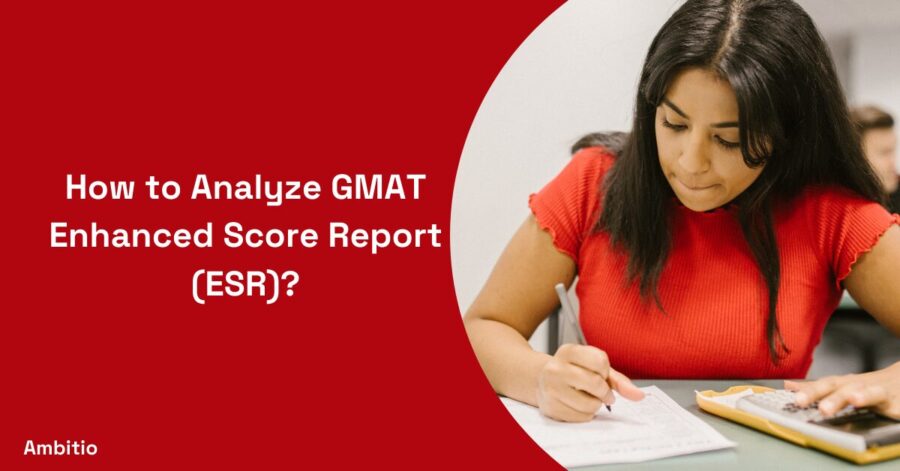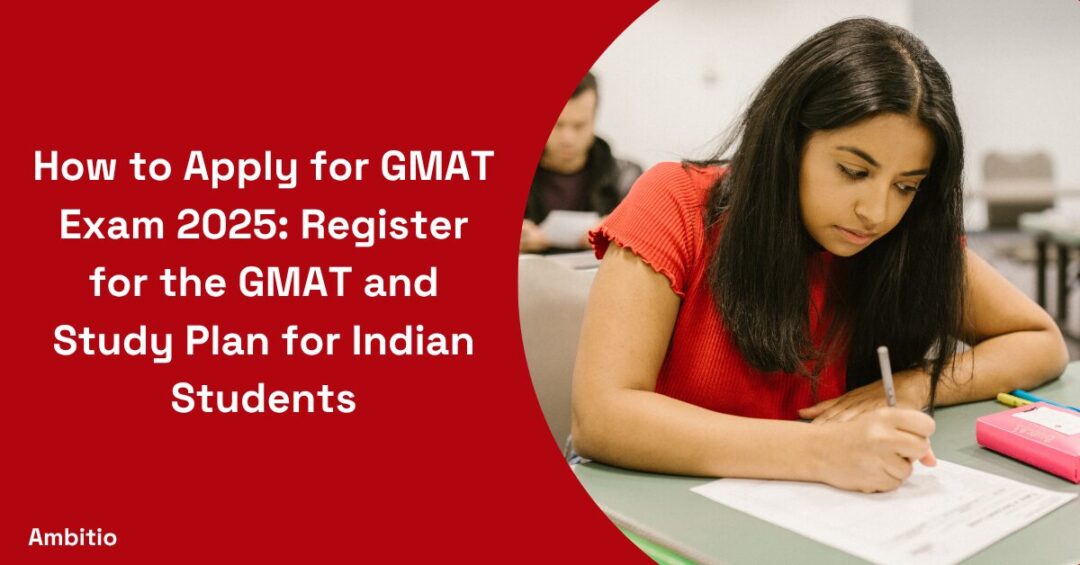4 September 2024
9 minutes read
GMAT Syllabus 2024: Section-Wise GMAT Focus Exam Syllabus

Key Takeaways
- The new GMAT Focus Edition streamlines the test to reflect real-world business skills, emphasizing data analysis and critical thinking.
- Success hinges on integrated preparation across Quant, Verbal, and Data Insights sections, not just isolated subject mastery.
- Smart time management and consistent practice with official materials are your best allies in tackling this condensed, high-stakes exam.
Did you know that over 200,000 aspiring business professionals take the GMAT each year? As the gateway to top MBA programs, this exam can make or break career aspirations. Yet, many test-takers find themselves overwhelmed by the breadth of material and uncertain about where to focus their efforts.
The ever-evolving nature of the test adds another layer of complexity, leaving students scrambling to keep up with the latest changes.
Enter the GMAT Focus Edition, launched in late 2023. This streamlined version aims to address common pain points, cutting test time nearly in half while maintaining its rigor. But what exactly does this mean for your prep strategy?
Let’s dive into the 2024 GMAT syllabus, breaking down each section to help you target your studies effectively. Whether you’re a first-time test-taker or looking to improve your score, understanding these changes is crucial for success.
GMAT Exam Pattern 2024
The GMAT exam pattern 2024 brings significant changes with the introduction of the GMAT Focus Edition. This new format streamlines the test into three sections: Quantitative Reasoning, Verbal Reasoning, and Data Insights. The entire exam now takes just 2 hours and 15 minutes, a major reduction from the previous version. Also, get a clear idea of what a good GMAT score is as well.
Let’s break down each section of the GMAT syllabus 2024:
Quantitative Reasoning: This section tests your skill to solve GMAT problem-solving questions and data sufficiency abilities. You’ll encounter questions that measure your capacity to analyze data and relationships between two entities.
Verbal Reasoning: Here, you’ll face reading comprehension and critical reasoning questions. This section assesses your ability to read passages, interpret information, and evaluate arguments. Try solving GMAT official advanced questions to get better here.
Data Insights: A new addition to the GMAT Focus Edition syllabus, this section combines elements of the former Integrated Reasoning section. It includes multi-source reasoning, table analysis, graphics interpretation, and two-part analysis questions. The GMAT preparation time varies according to your specific skillset, so prepare your study plan accordingly.
Each section is scored on a scale, contributing to your overall GMAT score. To effectively prepare, you’ll need a solid GMAT study plan and high-quality GMAT course or study material. The official GMAT guide remains an essential resource for understanding the exam format and types of questions you’ll encounter.
Remember, success on the GMAT requires more than just memorizing facts. You’ll need to develop your analytical reasoning skills and ability to interpret complex information. As you cover the GMAT syllabus, focus on honing these critical thinking abilities across all question types.
GMAT Exam Syllabus 2024
Let’s dive into the nitty-gritty of the GMAT syllabus 2024. This isn’t your typical standardized test, and knowing what to expect can give you a serious edge. So understand the purpose of GMAT exam before you dive right into it.
Quantitative Reasoning
Think less about complex calculus and more about real-world problem-solving. You’ll crunch numbers, sure, but it’s all about applying that math to business scenarios. Data sufficiency questions are the wildcards here – they’ll test how quickly you can spot what information you actually need.
Verbal Reasoning
GMAT reading comprehension isn’t just about understanding the text. You’ll need to read between the lines, make inferences, and apply the information to new situations. This is what makes GMAT a pretty important exam. Critical reasoning will push your logical thinking skills to the limit. Can you spot a flawed argument or strengthen a weak one?
Data Insights
This new section is where things get interesting. You’ll juggle multiple data sources, interpret graphs that would make most people’s heads spin, and draw conclusions that could impact business decisions. It’s not just about the numbers – it’s about telling the story behind them. Choose the right GMAT books to help you in the journey.
Remember, the GMAT test is as much about endurance as it is about knowledge. Your preparation should include building up your mental stamina. Practice working under time pressure and switching gears between different question types. It’s a marathon, not a sprint – so train accordingly.
GMAT Exam Syllabus 2024 Sections
Let’s dive deeper into the GMAT exam syllabus 2024 sections, breaking down the key topics you’ll need to master for each. Keep in mind that GMAT is an adaptive test.
Quantitative Reasoning
This GMAT quant section tests your math skills in practical contexts. Key areas include:
- Arithmetic: Fractions, decimals, percentages, ratios
- Algebra: Equations, inequalities, functions
- Geometry: Areas, volumes, coordinate geometry
- Word problems: Rate, work, mixture problems
- Data sufficiency: Determining if given information is enough to solve the problem
Verbal Reasoning
Critical reasoning and reading comprehension form the backbone of this section. Topics include:
- Reading Comprehension: Main idea, inference, tone, structure
- Critical Reasoning: Strengthen/weaken arguments, assumptions, conclusions
- Sentence Correction: Grammar, meaning, concision
Data Insights
This new section measures your ability to analyze complex data. You’ll encounter:
- Multi-source reasoning: Synthesizing information from text, tables, and graphics
- Table analysis: Interpreting data presented in tabular format
- Graphics interpretation: Analyzing trends and patterns in graphs
- Two-part analysis: Solving problems with multiple conditions
Your plan of action should involve tackling each of these areas systematically. Use the official guide to familiarize yourself with the question types, then practice solving problems under timed conditions.
Remember, the GMAT critical reasoning syllabus isn’t just about memorization – it’s about developing your analytical skills. Focus on understanding the underlying principles, and you’ll be well-equipped to handle whatever questions come your way.
GMAT Quantitative Reasoning Syllabus
If you’re gearing up to appear for the GMAT exam, understanding the Quantitative Reasoning syllabus is crucial. This section has been streamlined in the latest version of the GMAT, but don’t be fooled – it’s still a rigorous test of your math skills. Understand the benefits of GMAT and streamline your preparation for cracking the GMAT.

The syllabus consists of two main question types:
- Problem Solving: These are straightforward math questions that test your ability to crunch numbers and apply concepts. Master your GMAT time to ace this section.
- Data Sufficiency: Here’s where things get tricky. You’ll need to determine if the given information is enough to solve a problem, not actually solve it.
Key topics to master as you prepare for GMAT Quant include:
- Arithmetic: Focus on ratios, percentages, and number properties.
- Algebra: Equations, inequalities, and functions are common themes.
- Geometry: Brush up on areas, volumes, and coordinate geometry.
- Word Problems: Practice translating real-world scenarios into mathematical equations.
Remember, GMAT questions often have a business angle. You might analyze profit margins, interpret market trends, or calculate compound interest. The key is to apply basic math concepts to complex scenarios quickly.
As you study, don’t just memorize formulas. Focus on understanding the underlying principles. Practice with official GMAT questions to get a feel for the exam style. Resources like GMAT Club can be invaluable for extra practice and insights from other test-takers.
Pro tip: Time management is crucial. You’ll have about two minutes per question, so practice solving problems efficiently. The syllabus for the GMAT Quant section may seem daunting, but with a structured approach and consistent practice, you’ll be well-prepared to beat the GMAT.
GMAT Verbal Reasoning Syllabus
The Verbal Reasoning section of the GMAT exam is a crucial component of your GMAT syllabus preparation. Unlike the traditional GMAT, which consisted of four main sections, the new Focus Edition has streamlined the test while maintaining its rigor.
This section tests three key areas:
Reading Comprehension: You’ll analyze passages on various topics, from business to science. Focus on:
- Identifying main ideas and supporting details
- Making inferences
- Understanding author’s tone and purpose
Critical Reasoning: These questions test your ability to evaluate arguments. Practice:
- Strengthening or weakening arguments
- Identifying assumptions
- Drawing valid conclusions
Sentence Correction: While not in the Focus Edition, it’s worth noting for those taking the traditional format. It tests your grasp of English grammar and effective expression. GMAT sentence correction is a super-important part of the verbal section.
To excel in the Verbal section, start your preparation with the official GMAT guide. It provides the most accurate representation of actual test questions. Develop a habit of active reading – don’t just skim, but engage critically with the text.
Remember, the Verbal section isn’t just about English skills. It’s designed to assess how you process and analyze information – crucial abilities for the Data Insights section of the GMAT and your future business career. Incorporate this into your GMAT study plan as well.
Pro tip: Don’t underestimate this section. Many test-takers focus heavily on Quant, but a strong Verbal score can significantly boost your overall GMAT score. Balance your study time accordingly.
GMAT Data Insights Section Syllabus
The Data Insights section is the newest addition to the GMAT, replacing the Integrated Reasoning section in the updated GMAT syllabus. It’s designed to test your ability to analyze complex data – a crucial skill in today’s data-driven business world. Also keep in mind the GMAT score validity to plan your future academic journey.

Here’s what you need to know about this section:
Multi-Source Reasoning: You’ll synthesize information from multiple sources (text, tables, graphs). Practice:
- Identifying relevant data across different formats
- Drawing conclusions from combined sources
Table Analysis: Expect to interpret data presented in tables. Focus on:
- Quickly identifying trends and patterns
- Making comparisons between different data points
Graphics Interpretation: You’ll analyze various types of graphs and charts. Work on:
- Understanding different graph types (line, bar, scatter plots)
- Extrapolating data to make predictions
Two-Part Analysis: These questions test your ability to solve complex problems with multiple conditions.
To prepare effectively, start with the GMAT Official Guide. It provides the most accurate representation of what you’ll face on test day. Supplement this with other GMAT prep resources that focus specifically on data analysis and interpretation.
Pro tip: Don’t just memorize formulas or techniques. The key to success in this section is developing your ability to quickly digest and analyze information. Practice with real-world business reports and data sets to sharpen these skills. Keep in handy your GMAT admit card before the exam to avoid any mess.
GMAT Syllabus 2024 Preparation Tips
Ready to tackle the GMAT? Here are some key preparation tips for the 2024 syllabus, tailored for the new 2-hour and 15-minute long exam:
- Take a practice test to identify your strengths and weaknesses. This will help you allocate study time effectively across each section of the GMAT Focus. Start with a GMAT beginners guide to help you with the process.
- With the shortened exam, pacing is crucial. Practice working quickly but accurately. Aim to spend about 2 minutes per question in the Quant and Verbal sections.
- Whether it’s Data Insights or Critical Reasoning, give extra attention to sections where you struggle. But don’t neglect your strong suits – maintain those skills too.
- The GMAT Official Guide is your best friend. It provides the most accurate representation of actual test questions. Supplement with other reputable GMAT prep resources. Remember that GMAT is for abroad as well.
- The comprehensive GMAT Focus tests your ability to apply skills across sections. Practice connecting quantitative and verbal reasoning skills, especially for the Data Insights section.
- Consistency is key. Set aside regular study time and stick to it. Even 30 minutes daily is better than sporadic cram sessions.
- As you get closer to your test date, take full-length practice exams under timed conditions. This builds stamina and familiarizes you with the test format.
- Don’t just focus on getting questions right. When you make errors, understand why and how to avoid similar mistakes in the future.
GMAT Focus Edition Syllabus 2024
The GMAT Focus Edition Syllabus 2024 marks a significant evolution in the exam’s structure and content. This streamlined version condenses the test into a 2-hour and 15-minute format, focusing on three core sections: Quantitative Reasoning, Verbal Reasoning, and Data Insights. Each section is designed to assess skills crucial for success in business school and beyond.
In the Quantitative Reasoning section, you’ll tackle problem-solving and data sufficiency questions. This part of the exam tests your mathematical prowess and analytical thinking, covering topics from arithmetic and algebra to geometry and data analysis. The key here isn’t just about crunching numbers, but applying mathematical concepts to solve business-related problems efficiently.
The Verbal Reasoning section has been refined to focus on reading comprehension and critical reasoning. Gone are the sentence correction questions, shifting the emphasis to your ability to analyze written material, understand complex arguments, and draw logical conclusions. This change reflects the importance of clear communication and analytical thinking in the business world.
Perhaps the most significant update is the new Data Insights section, which replaces the former Integrated Reasoning portion. This section challenges you to interpret and analyze data from multiple sources, including tables, graphs, and text. You’ll encounter multi-source reasoning, table analysis, graphics interpretation, and two-part analysis questions. This addition underscores the growing importance of data-driven decision making in modern business environments.
To prepare effectively for the GMAT Focus Edition, it’s crucial to use a combination of official GMAT study materials and reputable prep resources.
Conclusion
As we wrap up our deep dive into the GMAT Focus Edition Syllabus 2024, it’s clear that this updated exam is more than just a test of knowledge—it’s a gateway to your future in business leadership. The streamlined format and enhanced focus on data analysis reflect the evolving demands of the business world.
Remember, success on the GMAT isn’t just about memorizing facts or formulas. It’s about developing a strategic mindset, honing your analytical skills, and learning to make decisions under pressure.
As you prepare, focus on understanding concepts deeply and applying them to real-world scenarios. With dedicated effort and smart preparation, you’ll not only conquer the GMAT but also lay a solid foundation for your MBA journey and beyond. Good luck, and may your GMAT score open doors to exciting opportunities in the world of business!
Elevate your GMAT performance and unlock the doors to prestigious business schools with Ambitio’s comprehensive preparation tools. Our expertly designed resources and personalized strategies will help you master each section of the GMAT, ensuring you achieve a score that sets you apart in the competitive admissions landscape.
FAQs
How long is the new GMAT Focus Edition?
The GMAT Focus Edition is 2 hours and 15 minutes long, significantly shorter than the traditional format.
What are the main sections in the GMAT Focus Edition?
The exam consists of three sections: Quantitative Reasoning, Verbal Reasoning, and Data Insights.
Is sentence correction still part of the GMAT?
No, sentence correction has been removed from the Verbal section in the GMAT Focus Edition.
What’s new in the Data Insights section?
The Data Insights section replaces Integrated Reasoning, focusing on multi-source reasoning, table analysis, graphics interpretation, and two-part analysis.
How should I prepare for the GMAT Focus Edition?
Use official GMAT materials, practice time management, focus on integrated thinking skills, and simulate test conditions regularly.
Is the GMAT Focus Edition easier than the traditional GMAT?
While shorter, the Focus Edition isn’t necessarily easier. It’s designed to be equally rigorous, testing core skills needed for business school.
How important is the Data Insights section?
Very important. It reflects the growing emphasis on data-driven decision making in business and contributes significantly to your overall score.

You can study at top universities worldwide!
Get expert tips and tricks to get into top universities with a free expert session.
Book Your Free 30-Minute Session Now! Book a call now




























